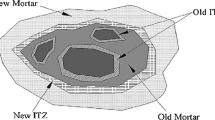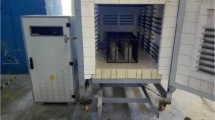Abstract
The behaviour of concrete made with recycled concrete aggregates (RCA) at room temperature is well-studied. However, some points still need to be addressed, especially in extreme conditions such as durability and high temperature. This paper evaluates the effect of elevated temperatures on the durability of concrete made with RCA. Three concrete mixes were studied: concrete with NA (reference), \({100}\,\%\) direct replacement (DR) mix (RCA-100-DR) and \({100}\,\%\) strength-based replacement (SBR) mix (RCA-100-SBR). The latter was designed to achieve the same performance as concrete made with NA. Mixes were exposed to temperatures of \({200}\,^\circ \hbox {C}\), \({400}\,^\circ \hbox {C}\) and \({600}\,^\circ \hbox {C}\). After cooling, durability-loss due to thermal exposure was evaluated through water porosity, capillary water absorption, permeability, chloride diffusion and accelerated carbonation tests. At room temperature, the direct addition of RCA decreased all durability parameters. The SBR mix recovered some of the durability properties. Exposure to high temperatures decreases all the properties, but it varies depending on the property. The concrete made with NA and the SBR mix showed similar performance. The durability was also evaluated using a performance-based approach, both at room and high-temperature. The proposed approaches showed potential to evaluate durability indicators, but they should be considered with precaution. Overall, concrete made with RCA reduces the durability of concrete, with or without heat damage, but this decrease can be reduced with proper mix optimization. These evaluations contribute to the post-heating durability of concrete structures made with RCA, which is fundamental to the post-fire assessment of concrete structures.











Similar content being viewed by others
Availability of data and materials
All experimental data that support the findings of this study can be obtained from the corresponding author.
References
de Brito J, Saikia N (2013) Recycled aggregate in concrete. Springer, London, p 448. https://doi.org/10.1007/978-1-4471-4540-0
Shi C, Li Y, Zhang J, Li W, Chong L, Xie Z (2016) Performance enhancement of recycled concrete aggregate - A review. J Clean Prod 112:466–472. https://doi.org/10.1016/j.jclepro.2015.08.057
Nedeljković M, Visser J, Šavija B, Valcke S, Schlangen E (2021) Use of fine recycled concrete aggregates in concrete: a critical review. J Build Eng 38:102196. https://doi.org/10.1016/j.jobe.2021.102196
Le H-b, Bui Q-B (2020) Recycled aggregate concretes - A state-of-the-art from the microstructure to the structural performance. Constr Build Mater 257:119522. https://doi.org/10.1016/j.conbuildmat.2020.119522
de Larrard F, Colina H (2019) Conclusion. In: de Larrad F, Colina H (eds) Concrete recycling: research and practice. CRC Press, Boca Raton, pp 544–545
Behera M, Bhattacharyya SK, Minocha AK, Deoliya R, Maiti S (2014) Recycled aggregate from C &D waste & its use in concrete - A breakthrough towards sustainability in construction sector: a review. Constr Build Mater 68:501–516. https://doi.org/10.1016/j.conbuildmat.2014.07.003
Wang R, Yu N, Li Y (2020) Methods for improving the microstructure of recycled concrete aggregate?: a review. Constr Build Mater 242:118164. https://doi.org/10.1016/j.conbuildmat.2020.118164
Guo H, Shi C, Guan X, Zhu J, Ding Y, Ling TC, Zhang H, Wang Y (2018) Durability of recycled aggregate concrete - A review. Cement Concr Compos 89:251–259. https://doi.org/10.1016/j.cemconcomp.2018.03.008
Fernandes B, Carré H, Mindeguia J-C, Perlot C, La Borderie C (2021) Effect of elevated temperatures on concrete made with recycled concrete aggregates-an overview. J Build Eng 74:103235. https://doi.org/10.1016/j.jobe.2021.103235
Kou SC, Poon CS, Etxeberria M (2014) Residue strength, water absorption and pore size distributions of recycled aggregate concrete after exposure to elevated temperatures. Cement Concr Compos 53:73–82. https://doi.org/10.1016/j.cemconcomp.2014.06.001
Xuan D, Zhan B, Poon CS (2017) Thermal and residual mechanical profile of recycled aggregate concrete prepared with carbonated concrete aggregates after exposure to elevated temperatures. Fire Mater 42(1):134–142. https://doi.org/10.1002/fam.2465
Laneyrie C, Beaucour A-L, Green MF, Hebert RL, Ledesert B, Noumowe A (2016) Influence of recycled coarse aggregates on normal and high performance concrete subjected to elevated temperatures. Constr Build Mater 111:368–378. https://doi.org/10.1016/j.conbuildmat.2016.02.056
Ma Z, Ba G, Duan Z (2019) Effects of high temperature and cooling pattern on the chloride permeability of concrete. Adv Civil Eng. https://doi.org/10.1155/2019/2465940
Ma Z, Liu M, Tang Q, Liang C, Duan Z (2020) Chloride permeability of recycled aggregate concrete under the coupling effect of freezing-thawing, elevated temperature or mechanical damage. Constr Build Mater 237:117648. https://doi.org/10.1016/j.conbuildmat.2019.117648
Valente Monteiro A, Vieira M (2021) Effect of elevated temperatures on the residual durability-related performance of concrete. Mater Struct 54(6):13–15. https://doi.org/10.1617/s11527-021-01824-5
Comité Européen de Normalisation: NF EN 206/CN: Béton - Spécification, Performance, Production et Conformité - Complément National à la Norme NF EN 206. Brussels (2014). Comité Européen de Normalisation
de Larrard F, Sedran T BetonLab (2021). https://betonlabpro.ifsttar.fr/
Fernandes B, Carré H, Mindeguia J-C, Perlot C, La Borderie C (2022) Spalling behaviour of concrete made with recycled concrete aggregates. Constr Build Mater 344:128124. https://doi.org/10.1016/j.conbuildmat.2022.128124
Fernandes B (2022) Fire behaviour, spalling and residual durability of concrete made with recycled concrete aggregates. PhD thesis, Université de Pau et des Pays de l’Adour
Comité Européen de Normalisation: NF EN 12350-2: Testing fresh concrete - Part 2 : slump test. Brussels (2019). Comité Européen de Normalisation
Comité Européen de Normalisation: NF EN 12390-3: testing hardened concrete - Part 3 : compressive strength of test specimens. Brussels (2019). Comité Européen de Normalisation
Comité Européen de Normalisation: NF EN 12390-6: testing hardened concrete - Part 6 : tensile splitting strength of test specimens. Brussels (2012). Comité Européen de Normalisation
Comité Européen de Normalisation: NF EN 12390-13: Testing hardened concrete - Part 13 : determination of secant modulus of elasticity in compression. Brussels (2021). Comité Européen de Normalisation
Association Française de recherches et d’essais sur les matériaux et constructions: APC-AFREM: Durabilité des Betons - Méthodes Recommandés Pour la Mesure des Granulats Associées a la durabilité. Toulouse (1997). Association Française de recherches et d’essais sur les matériaux et constructions
Kollek JJ (1989) The determination of the permeability of concrete to oxygen by the Cembureau method-a recommendation. Mater Struct 22(3):225–230. https://doi.org/10.1007/BF02472192
PCD RT (1999) Permeability of concrete as a criterion of its durability. Mater Struct 32: 174–179
Klinkenberg L (1941) The permeability of porous media to liquids and gases. In: Drilling and production practice, 200–214. American Petroleum Institute
Miah MJ, Kallel H, Carré H, Pimienta P, La Borderie C (2019) The effect of compressive loading on the residual gas permeability of concrete. Constr Build Mater 217:12–19. https://doi.org/10.1016/j.conbuildmat.2019.05.057
Carré H, Perlot C, Daoud A, Miah MJ, Aidi B (2016) Durability of ordinary concrete after heating at high temperature. In: Key engineering materials, 711: 428–435. Trans Tech Publ
Truc O, Ollivier JP, Carcassès M (2000) A new way for determining the chloride diffusion coefficient in concrete from steady state migration test. Cem Concr Res 30(2):217–226. https://doi.org/10.1016/S0008-8846(99)00232-X
Perlot C, Verdier J, Carcassès M (2006) Influence of cement type on transport properties and chemical degradation: application to nuclear waste storage. Mater Struct 39(5):511–523. https://doi.org/10.1617/s11527-005-9020-9
Rozière E, Loukili A, Cussigh F (2009) A performance based approach for durability of concrete exposed to carbonation. Constr Build Mater 23(1):190–199. https://doi.org/10.1016/j.conbuildmat.2008.01.006
Association Française de Normalization: XP P18-458: Essai Pour Béton Durci - Essai de Carbonatation Accélérée - Mesure de L’épaisseur de Béton Carbonaté. (2008). Association Française de Normalization
Beushausen H, Alexander MG, Basheer MG, Baroghel-Bouny V, d’Andréa R, Gonçalves A, Gulikers J, Jacobs F, Khrapko M, Monteiro AV, Nanukuttan SV, Otieno M, Polder R, Torrent R (2016) Principles of the performance-based approach for concrete durability. In: Beushausen H, Luco LF (eds) Performance-based specification and ccntrol of concrete durability: specifications state-of-the-art report RILEM TC 230-PSC. Springer, London, pp 107–131
Auroy M, Poyet S, Le Bescop P, Torrenti JM, Charpentier T, Moskura M, Bourbon X (2018) Comparison between natural and accelerated carbonation (3% CO2): impact on mineralogy, microstructure, water retention and cracking. Cem Concr Res 109:64–80. https://doi.org/10.1016/j.cemconres.2018.04.012
Castellote M, Fernandez L, Andrade C, Alonso C (2009) Chemical changes and phase analysis of OPC pastes carbonated at different CO2 concentrations. Mater Struct 42(4):515–525. https://doi.org/10.1617/s11527-008-9399-1
Sisomphon K, Franke L (2007) Carbonation rates of concretes containing high volume of pozzolanic materials. Cem Concr Res 37(12):1647–1653. https://doi.org/10.1016/j.cemconres.2007.08.014
Rougeau P, Schmitt L, Mai-Nhu J, Djerbi A, Sailio M, Ghorbel E, Mechling JM, Lecomte A, Trauchessec R, Bulteel D, Cyr M, Leklou N, Amiri O, Moulin I, Lenormand T (2019) Durability-related properties. In: de Larrad F, Colina H (eds) Concrete recycling: research and practice. CRC Press, Boca Raton, pp 214–250
Mindeguia J-C, Pimienta P, Carré H, La Borderie C (2012) On the influence of aggregate nature on concrete behaviour at high temperature. Eur J Environ Civ Eng 16(2):236–253. https://doi.org/10.1080/19648189.2012.667682
Pimienta P, Alonso MC, Jansson McNamee R, Mindeguia J-C (2017) Behaviour of high-performance concrete at high temperatures: some highlights. RILEM Tech Lett 2(2017):45. https://doi.org/10.21809/rilemtechlett.2017.53
Kwan WH, Ramli M, Kam KJ, Sulieman MZ (2012) Influence of the amount of recycled coarse aggregate in concrete design and durability properties. Constr Build Mater 26(1):565–573. https://doi.org/10.1016/j.conbuildmat.2011.06.059
Gonçalves A, Esteves A, Vieira M (2004) Influence of recycled concrete aggregates on concrete durability. In: international RILEM conference on the use of recycled materials in buildings and structures, 554–562. RILEM Publications SARL
Kou SC, Poon CS (2012) Enhancing the durability properties of concrete prepared with coarse recycled aggregate. Constr Build Mater 35:69–76. https://doi.org/10.1016/j.conbuildmat.2012.02.032
Ghasemzadeh F, Pour-Ghaz M (2015) Effect of damage on moisture transport in concrete. J Mater Civ Eng 27(9):04014242. https://doi.org/10.1061/(asce)mt.1943-5533.0001211
Wang L, Zhang Q (2021) Investigation on water absorption in concrete after subjected to compressive fatigue loading. Constr Build Mater 299:123897. https://doi.org/10.1016/j.conbuildmat.2021.123897
Evangelista L, de Brito J (2010) Durability performance of concrete made with fine recycled concrete aggregates. Cement Concr Compos 32(1):9–14. https://doi.org/10.1016/j.cemconcomp.2009.09.005
Gomes M, De Brito J (2009) Structural concrete with incorporation of coarse recycled concrete and ceramic aggregates: durability performance. Mater Struct 42(5):663–675. https://doi.org/10.1617/s11527-008-9411-9
Silva RV, Neves R, De Brito J, Dhir RK (2015) Carbonation behaviour of recycled aggregate concrete. Cement Concr Compos 62:22–32. https://doi.org/10.1016/j.cemconcomp.2015.04.017
Dhir R, Limbachiya M, Leelawat T (1999) Suitability of recycled concrete aggregate for use in bs 5328 designated mixes. Proc Inst Civil Eng-Struct Build 134(3):257–274
Kaid N, Cyr M, Julien S, Khelafi H (2009) Durability of concrete containing a natural pozzolan as defined by a performance-based approach. Constr Build Mater 23(12):3457–3467. https://doi.org/10.1016/j.conbuildmat.2009.08.002
San Nicolas R, Cyr M, Escadeillas G (2014) Performance-based approach to durability of concrete containing flash-calcined metakaolin as cement replacement. Constr Build Mater 55:313–322. https://doi.org/10.1016/j.conbuildmat.2014.01.063
Idir R, Cyr M, Pavoine A (2020) Investigations on the durability of alkali-activated recycled glass. Constr Build Mater 236:117477. https://doi.org/10.1016/j.conbuildmat.2019.117477
Bucher R, Cyr M, Escadeillas G (2021) Performance-based evaluation of flash-metakaolin as cement replacement in marine structures - case of chloride migration and corrosion. Constr Build Mater. https://doi.org/10.1016/j.conbuildmat.2020.120926
Association Française de Génie Civil: Conception des Bétons Pour Une Durée de Vie Donnée des Ouvrages - Maîtrise de la Durabilité Vis-à-vis de la Corrosion des Armatures et de L’alcali-réaction. Paris (2004). Association Française de Génie Civil
Acknowledgements
The authors would like to thank the support of Groupe Cassous (Guyenne Environnement and AQIO) and Groupe Garandeau.
Funding
This study was funded by Région Nouvelle-Aquitaine (project RECYFEU).
Author information
Authors and Affiliations
Corresponding author
Ethics declarations
Conflict of interest
The authors declare that they have no conflicts of interest.
Additional information
Publisher's Note
Springer Nature remains neutral with regard to jurisdictional claims in published maps and institutional affiliations.
Rights and permissions
Springer Nature or its licensor (e.g. a society or other partner) holds exclusive rights to this article under a publishing agreement with the author(s) or other rightsholder(s); author self-archiving of the accepted manuscript version of this article is solely governed by the terms of such publishing agreement and applicable law.
About this article
Cite this article
Fernandes, B., Khodeir, M., Perlot, C. et al. Durability of concrete made with recycled concrete aggregates after exposure to elevated temperatures. Mater Struct 56, 25 (2023). https://doi.org/10.1617/s11527-023-02111-1
Received:
Accepted:
Published:
DOI: https://doi.org/10.1617/s11527-023-02111-1




